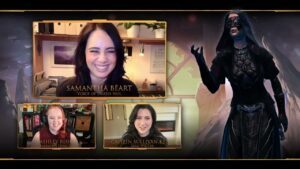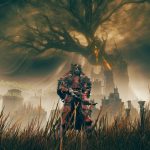Ahsoka episode 5 is here, something we—and by “we” I mean Clone Wars fans, Anakin Skywalker apologists, and Star Wars nostalgists—have been awaiting for a very long time. Will Anakin get redemption? Will Ahsoka get closure? Will the live-action version of this thing we’ve seen before crackle with new energy, imbued by the powerful acting of Rosario Dawson and Hayden Christensen? The answer is—sort of.
While it shows flashes of brilliance, and some of the most beautiful visuals I’ve seen in Star Wars, period, the latest episode of the Ahsoka TV series occasionally falls victim to the disease of Star Wars nostalgia, whereby characters and clothing and facial expressions and lightsaber twists are there just to be there, just so you can do the Captain America in The Avengers meme, just so you can understand that reference. It takes a second watch to really understand showrunner Dave Filoni’s intentions in so much of this episode, which shouldn’t be the case.
Read More: Ahsoka Episode 4 Review: You’re Exactly The Way I Remember You
Stream Ahsoka: Disney+
Did I, as a fan, feel satiated after finally witnessing Anakin and Ahsoka together in live action? In some ways, sure, but in others the experience left me wanting, like the meal Filoni served was just dessert, all fluffy meringues and candied fruit when what I really wanted was a heaping, savory plate.
Let’s get into the nitty gritty of Ahsoka episode 5, titled “Shadow Warrior.”

Searching on Seatos
We begin on, you guessed it, Seatos, where Hera Syndulla, her son Jacen, and war criminal Chopper have landed a little too late. No one’s there, or at least, it seems that way—poor Huyang is hiding behind one of the rocks, cradling Sabine’s Mandalorian helmet.
“I told them to stay together,” he said. “They never listen.” Cue the title card, and a reminder that the sound design on this show is stellar, before we get to what we all really want to see: Anakin and Ahsoka in the World Between Worlds.
Though my heart is aflutter the moment the episode snaps to the former master and apprentice facing each other in such a surreal, star-studded space, a nagging thought pokes at the back of my head. It persists throughout the episode, like the slight, aching headache I get after partaking in a few too many Aperol Spritzes at brunch: Why?
I said last week that I was looking forward to Ahsoka and Anakin having the conversation they needed to have and that we needed to hear, but Anakin isn’t here to talk. After telling her “you look old” and gently razzing her for losing her fight, he suggests that her ability to remember what happened gives her a chance at living.
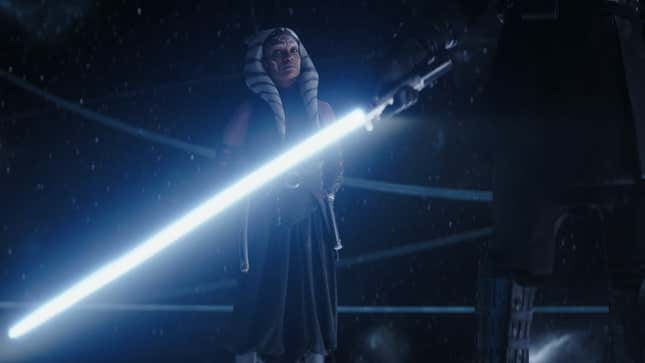
But he’s also here to fight. He tells Ahsoka that he wants to finish her training. “One is never too old to learn, Snips,” he says, and Hayden nails the Anakin attitude—a mix of know-it-all wryness and somber observation. I agree with him here, Ahsoka needs to learn more—but she doesn’t need to swing lightsabers, she needs to talk to the man who was essentially her brother. No, according to Filoni, her last lesson is choosing whether to live or die, which seems so at odds with her character.
The episode tries to loosely establish that Ahsoka has, somehow, given up, but was I watching a different show before this? Ahsoka never felt like she had given up the fight, but rather that she had closed herself off to personal connections, something that Anakin (who was denied personal connection, sought it anyway, and suffered because of it) could help her unpack more than anyone.
Despite this, Filoni seems determined to give us a fight, anyway, and the brief notes of Darth Vader’s theme that played at the end of the last episode now feel like they were an ominous portent, not just a fun little detail. We’re getting all the shades of Anakin Skywalker here, whether we like it or not—this ain’t your daddy’s Force ghost, but an actual specter, meant to represent Ahsoka’s complicated relationship with her former master.
The Clone Wars
The episode consistently shows us what’s going on back on Seatos: Jacen Syndulla is using the Force sensitivity he inherited from his father to help locate Ahsoka, and Hera is using her non-sanctioned mission fleet to fly low over the ocean to find her. But these are its weakest moments, as every scene feels needlessly dragged out. We don’t need several scenes on Seatos, we need one, maybe two.
Ahsoka refuses to fight Anakin in the World Between Worlds, but is forced to anyway, and the two clash laser swords. Did I squeal with glee watching Christensen do the now-infamous Anakin Skywalker twirl? Of course I did. Did that nagging ache at the back of my head pulse with confusion? You bet. They playfully spar, Ahsoka kicks Anakin in the face, and just as she suggests he has nothing left to teach her, Anakin slices the shimmering walkway out from underneath her and sends her hurtling through space.
Ahsoka lands flat on her face in sand, surrounded by smoke in a pink-hued space, a visual nod to the 1980 Akira Kurosawa film Kagemusha, whose title translates to Shadow Warrior (I see what you did there). But she’s not the Ahsoka we just saw—she’s the teenage version of her, played by Barbie’s Ariana Greenblatt. She realizes she’s back in the Clone Wars just as Anakin from that time period strides past her, confidently deflecting blaster bolts in his snazzy armor. “Forward!” he screams—this is General Skywalker, the war hero, and it’s here that the starkness of the Clone Wars’ horrors are clearer than they’ve ever been—Ahsoka is just a child, thrust onto the frontlines of a war.
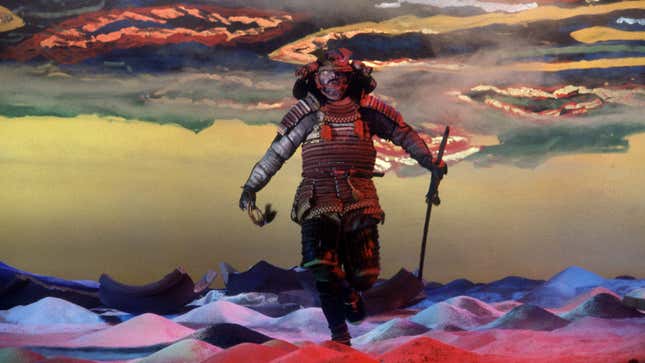
“Hurry up, Snips!” he yells, but she’s confused as to why they’re here, at one of their first-ever missions. She chases after him, deflecting bolts with her old (green) saber, and asks “What about my training?” “This is your training!” he yells as they run forward. When the smoke clears, the battle is over, and Ahsoka is looking out over scores of dead or injured Clone Troopers. She sits down and reaches out to touch one’s arm, and he instinctively reaches for her. It’s touching and somber, as it’s clear that she is shaken by this entire ordeal but still finds time for sympathy.
“We lost so many,” she says to Anakin, who is urging her to continue to fight. She’s hung up on the lives lost, and how their decisions led to it. He reassures her: The Jedi are meant to lead, but they make mistakes, and yes, those mistakes bother him. Christensen is great here—he feels like an older brother who is also tasked with an immense burden and flits between firm and sympathetic throughout. The two discuss the role of the Jedi in this time period, and how it’s shifted. “We must adjust to the times. When Obi-Wan taught me we were keepers of the peace, but now, to win this war, I have to teach you to be a soldier,” he explains.
She doesn’t want to fight, but he doesn’t care—she has to if she wants to live, and he strides off, leaving her to stare at him in horror. These flashback scenes are where Filoni’s struggles to adequately fill in the gaps between the stories he wants to tell and what he actually puts on-screen are the most clear. On first view, I was confused at how Anakin was portrayed here, as he seems to violently oscillate between caring, brotherly Master, vehement war leader, and Darth Vader himself. Then, on second viewing, I realize that this isn’t any version of Anakin other than the one in Ahsoka’s head.
The admittedly beautiful visual trick, where Anakin’s body forging onward into the smoke-filled battlefield is replaced, briefly, by Darth Vader’s, is clearly meant to show us how Ahsoka struggles to make sense of her relationship with her master. But it doesn’t feel like we’ve gotten enough of an understanding of how badly this affects her, how it travels with her everywhere, up until this point. It feels, in some ways, unearned.
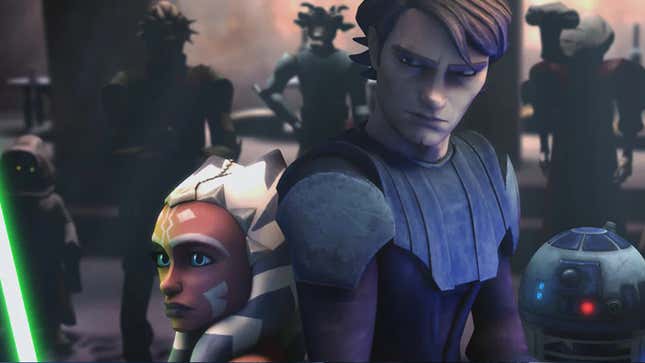
Shadows of the past
We get another too-long look at the Syndullas trying to find Ahsoka (although I adore Huyang telling Hera that people like her because she cares, and I do love Mary Elizabeth Winstead’s every facial expression and line read as her) before we get back to a different, iconic point in the Clone Wars.
We’ve now jumped to the Siege of Mandalore, a battle that Ahsoka took part in on her own, after she had left the Jedi Order. We get a brief cameo from Temuera Morrison, whose voice echoes from the helmet of a Tano Trooper (a battalion of Clone Troopers she led into battle after briefly returning to the war), before Anakin appears at her side. Anakin doesn’t remember this battle, because he was never there for it—this is taking place in tandem with the first half of Revenge of the Sith, the start of Anakin’s descent.
“You did well. You’re a warrior now, as I trained you to be,” he says. “Is that all?” she wonders. Anakin promises her that she’s part of a larger Jedi legacy, and she echoes the words that Baylan Skoll said to her on Seatos: “But my part of that legacy is one of death and war.” Anakin’s retort is crucial here, as it’s something we’ve wanted to hear come from Hayden Christensen’s mouth for more than 20 years: “But you’re more than that, because I’m more than that.”
Ahsoka doesn’t believe this—she’s too caught up in Baylan’s words, in the legacy Anakin left behind, in the horrors associated with Darth Vader (oddly, the threat of the Dark Side never felt like something Ahsoka has dealt with before, nor does it feel like something she should question). Her refusal to believe Anakin is “more than that” frustrates him. “Is that what this is about?” he asks, annoyed. At first watch, I thought this was a glib response, a weird reaction to someone suggesting that the genocide and destruction you left in your wake was bad, maybe. But then I realized, upon watching the scene again, that Anakin is hurt by her narrow-mindedness, that she, above anyone else, could and should be the person to understand the multifaceted nature of his character.
So, he shows her that face she is so desperate to see, that face of evil, of Vader, and he fights her yet again, this time with the outfit he wears on Mustafar. If this is the Anakin you want, this is the Anakin you’ll get. “I gave you a choice, live or die.”

It feels, in this moment, like we’re trying to do a bit too much here—are we redeeming Anakin in the eyes of Ahsoka, or of the viewers? Are we imbuing Ahsoka with a renewed will to live, but one that hinges on whether or not she can see that her master was more than a monster? This confusion could be due, in part, to dialogue choices, or perhaps the editing (which has been messy at times), but it is confusing nonetheless.
Anakin kicks young Ahsoka out of this memory and back into the World Between Worlds, where she’s her old self again. The same visual trick plays out again, a flicker of Darth Vader, but it’s tired this time, and only redeemed by Christensen’s incredible physicality, which makes his embodying of Anakin feel like slipping on a well-worn suit. “You lack conviction,” he says, echoing James Earl Jones’ vocal patterns. I love a good lightsaber fight, especially one in which Anakin’s strength is on full display, but I still can’t quite parse out why they are fighting, and what over.
She gets the better of him, and though her eyes briefly turn the same red as his thanks to the gleam of his saber (which she’s just disarmed of him of), she discards his weapon, throwing it into the abyss. “I choose to live,” she says, but it feels more like she’s refusing to put Anakin in the Vader box, and herself alongside with it—not that anyone ever really thought she would be until this very moment. In a single episode, Filoni seems to have set up and solved his own problems. “There’s hope for you yet,” Anakin says, before disappearing.
It feels like everyone in Star Wars is fighting over Anakin Skywalker’s charred body like the last chicken leg at the barbecue, each one hoping that a piece of this poor man will give them their own closure. Yet he’s left drifting in the wind of the World Between Worlds, forced to serve as a ferryman for all your meditation retreats.
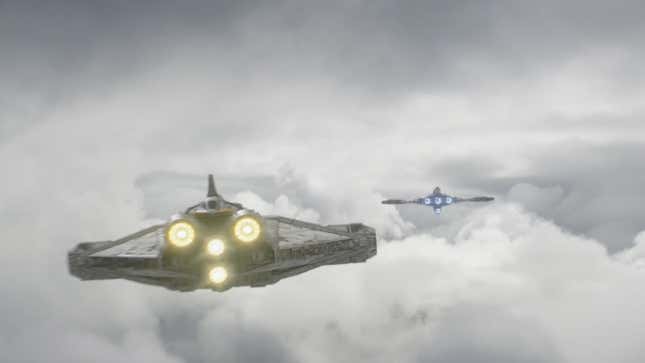
Ahsoka reborn
After Anakin serves his purpose, we get a beautiful visual of the World Between Worlds condensing until it becomes water lapping at Ahsoka’s feet. It overtakes her, and we see her body floating in Seatos’ ocean, where she’s rescued by one of Hera’s pilots. As she regains consciousness, Anakin’s name is on her lips. Was it all a dream? I’m not sure we’ll ever know, or if Filoni wants us to, but either way, the showrunner’s affinity for aligning Ahsoka with The Lord of the Rings’ Gandalf the Gray has now been translated to live-action—the next time we see her up and about, she’s in all white, and there’s something ”different” about her.
Ahsoka taps into the Force to find echoes of Sabine’s memory embedded in the pieces of the discarded map, and discovers that she’s gone with Baylan, Shin Hati, and Morgan Elsbeth to some far corner of another galaxy. She realizes that the only way to find her is to enlist the purrgil (space whales), who are conveniently back and in the middle of a cross-galaxy migration. While Hera and Carson Teva distract the New Republic ships that have appeared to strip Hera of her General status due to her insubordination, Ahsoka convenes with the largest whale in the pod.
Standing on top of her ship, her white frock flapping in the breeze, she reaches out with the Force and speaks to the whale, echoing the first time she ever showed her sensitivity to the universe’s life force, way back when she was just a little baby on Shili. It is breathtakingly beautiful, so much so that it nearly brings tears to my eyes, but that’s probably because I’m the same woman who rescues injured pigeons.
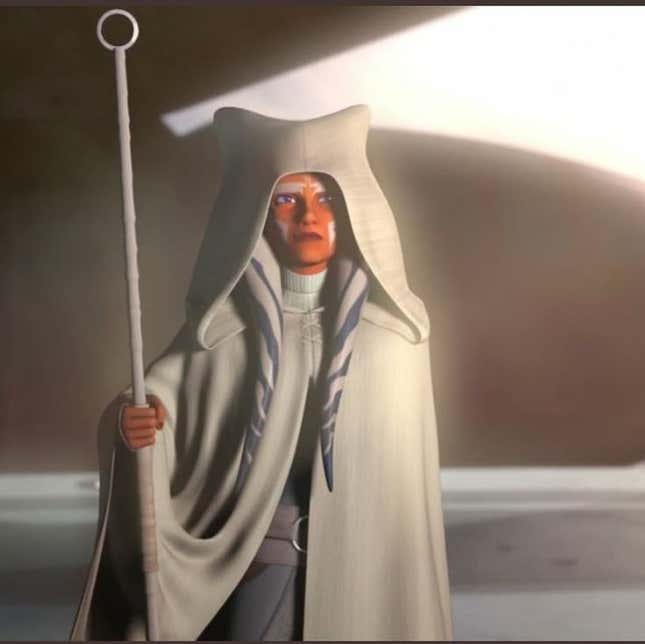
This Ahsoka is lighter in every way—she feels burdenless, ballooned by whatever closure she managed to get in the World Between Worlds (it confused the hell out of me, but good for you, girl). She instructs Huyang to fly the ship straight into the mouth of the whale, who has silently agreed to take them along for the journey.
“You’re certain they know where Sabine was taken?” Huyang asks as they park their ship on its tongue and its baleen teeth close them off to the skies. “I have no idea,” she says. “What?” he asks, perplexed. “No idea,” she says playfully. “We’ll just see where it goes…It’s better than going nowhere.” Okay, girl Gandalf, I’m here for it.
Ahsoka and Hera say their goodbyes as the purrgil prepare their jump to hyperspace, and the latter’s voice crack on the infamous “may the Force be with you” line sends a tear down my cheek. Then, with a satisfying whoosh, the pod disappears. To where? Who knows.
Ahsoka episode 5 has moments of brilliance and of beauty, but it gets bogged down in messy dialogue and confusing storytelling. Filoni has some great clay at his fingertips, I just want to see him mold it even better. My standards are high (I am writing this while wearing an Ahsoka Tano t-shirt), but I can say that aside from Andor, and despite my reservations, this is the best Star Wars story we’ve gotten in a very long time.
The next episode of Ahsoka airs on September 19 at 9 p.m. ET on Disney Plus.
Stream Ahsoka: Disney+
Update 09/13/2023 at 3:30 p.m. ET: Updated the air date for the next Ahsoka episode.




